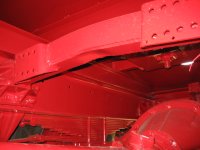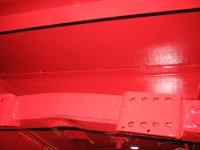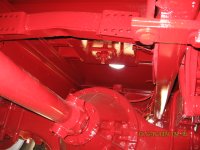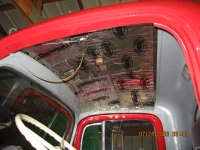Ah, ...WOW ..Jesse,....beautiful job and you really lucked out on the body shop, just fantastic!! I came across this thread today and read it right through as I too am an old fan of the '50's Whites.
I don't see any mention of the model, but it sure looks like a WB-28 to me as I drove them back in the 50's. We used to plow snow with a full rigged WB-28 with a dump body full of sand for ballast.
We also had the slightly smaller WC-22 with fifth-wheel for a float tractor and both were great trucks. That particular "red" is perfect. Labatt's Beer Company had a fleet of tractor trailers with the fancy "Cab-Forward" (not cab-over) and it was quite "round" and the semi trailer was rounded out in a goose-neck style and they all matched up something very beautiful!! (Seems to me that Labatt's also had some complete units painted "gold"?)(Correct me if my memory has tricked me!)
But my question was going to be in regard to Cab-construction. Yours of the '59 vintage appears to be all steel. Trying to think back all those years but I believe the models I'm familiar with were 1952, . . and the cab construction was "wood". Yes a nice quality "oak",..good hardwood and some of the most beautiful dovetail fitting you'd ever hope to see. Twas like the shop carpenters were really super-proud of their work, (strange for an assembly line cab), especially when the woodwork was to be covered and hidden in the body metal! Just thought of the rear cab window. It was very small and in the shape of a half-moon with the flat or straight on the bottom. It was all the rear window you needed because when you turned to peek over your shoulder, that little window was perfectly placed.
But I wondered if you happen to know when they stopped using the wood. I should add that the doors were also framed in wood and covered in body metal. The door handle hardware was really not unlike the door handle hardware in your house doors. (That is, if you happen to have the solid doors)
Yes wood with little steel striker plates etc.
And yes, I remember well the thickness of such as the fenders. Very similar to the heavy metal fenders (and body) on WWII army trucks. You could, (if you had a mind to?) bounce a heavy ballpeen hammer off one of those fenders and hardly dent it. (certainly you'd mark it, but not much,..honestly). Trucks were built to last in those days,...not like todays beautiful but plastic jobs!
If you could find some of those old Whites and Macks, Binders, Jimmys, Reo',s and such as the Diamond-T's and yes even those beautiful old Brockways that looked like overgrown Model-A's etc from the 50's era and some of the 1940's KB-14 Internationals(Binders), the big FWD with Buda Diesels, Oshkosh, Walters and as somebody else mentioned, the Mack B-61 Thermodyne diesels from that era, and geeeze all the ones that slip my mind they all had fenders (in particular) and other body work that might have been close to 3/8th or not likely 1/4 inch but when you wrapped your knuckles on 'em, you'd think so!! The Dodge Power-Wagons during the war may have infact, had 1/4 inch fenders? Can't swear to it.
Oh yes the mirrors. Sad, sad things they were. A little 3 or 4 inch dia. round mirror that sat on the end of a long, (tescoping) single arm. After the rust got to the little bolt that held it way out there, they generally just flopped and hung in a useless fashion, totally frustrating especially trying to back a trailer into a tight spot. West-coasters are heaven today!
. . . OH Good grief,...sorry bout that,..didn't mean to be lengthy again, I really got carried away in fond memory when I just wanted to compliment you on a beautiful job and ask about the wood?
Can't wait to see your completion! Great job man !!!! (Sorry for this!)
CHEERS !
. . tug






